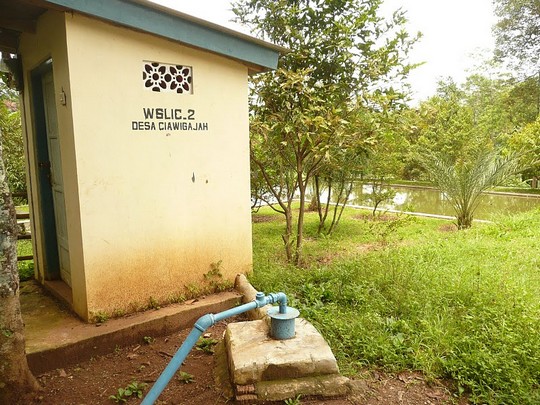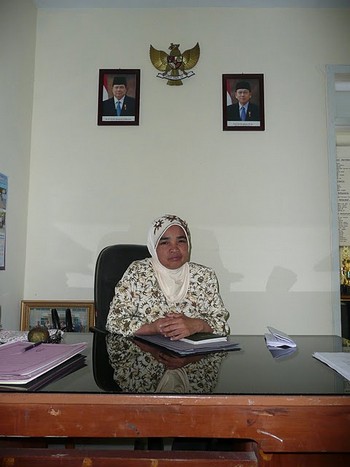Achmad Uzair Fauzan
Ibu Mutiarah, the dynamic head of Ciawigajah village.Achmad Uzair Fauzan |
Compared to its neighbours, Indonesia is abundant in water resources. However, with water consumption estimated to double by 2015, issues of water management and supply are likely to become increasingly important. With at least 80 per cent of Indonesia’s population having no access to piped water, supplying clean water is critical for well-being. The challenge is particularly great in rural areas where water infrastructure is generally absent and which have been greatly affected by urban-oriented development patterns. This article explains some new approaches to water management and village governance in two villages in West Java.
West Java’s Mount Ciremai (3078 m) has long been an important water catchment area for the surrounding districts of Cirebon, Kuningan and Majalengka, and for Cirebon municipality. With more than 140 springs producing a total of 6000 cubic metres per second, the area is the main water source for a regional population of approximately 4.7 million people. Several local government-owned water companies (PDAM or Perusahaan Daerah Air Minum) as well as private companies depend on and take profits from selling this water. Cirebon municipality’s PDAM alone reportedly takes 800 litres every second at a value of 37.5 billion rupiah (A$4.1 million) per year from the area. However, local people living around the water source report lack of water access and frequent conflict over water management.
Like in most communities in this region, residents of the villages of Sindangkasih and Ciawigajah depend on the Ciremai mountainous area for their water supply. These two villages are part of Beber subdistrict, located about 25 kilometres from the capital of Cirebon district. Despite the fact that a limited PDAM connection is already available in Sindangkasih, most people in both villages still depend on polluted rivers for their water, or draw water from wells owned by richer villagers. These wells are generally unhygienic and often run dry during the dry season.
Water projects
Because of their lack of regular access to clean water, some years ago the government provided these two villages with water projects. Sindangkasih received a water project from the Department of Public Works (Cipta Karya) in 2004. Ciawigajah had received a similar project from Cipta Karya in 1999and received further assistance in the form of a WSLIC (Water and Sanitation for Low Income Communities) project from The World Bank in 2007. At first, these projects involved providing water from springs that were located inside the villages’ own territories, the construction of water reservoirs and piping of water to designated places, such as village mosques.
In the beginning, Sindangkasih villagers were happy with the project. On its completion, clean water was supplied for the first time to village communal washing and bathing facilities and village mosques (where ablutions are obligatory before daily prayers). Because the water quality was good, many villagers wanted to have piped connections to water hydrants located around the village, so that they would be able to access it more easily.
The introduction of piped water also inspired the people of Sindangkasih to establish a water company owned by the village, creating a new source of village revenue. The company installed a metering and piping system to individual houses, at a cost of Rp.500,000 per house, with subsequent payments based on the water consumed by each household. Immediately, 198 households signed up. At a price of Rp.1000 per cubic metre, the company provided convenient and affordable clean water to the average village household for the first time, at cheaper rates than those charged by Cirebon PDAM. Cipta Karya estimates average water consumption for Indonesians is 144 litre per person per day, so the discount of 30 per cent that village households get on their monthly water bills (compared to what the Cirebon PDAM charges) is a big saving. During the first few months of operation, the village also reportedly raised Rp.2.5 million monthly from this water service.
However, this satisfaction with the new system did not last long. ‘For the construction, the project used a private contractor. They completed the installation in the rainy season,’ says Rohaman, a village official from Sindangkasih. Not anticipating that water flows would be much less in the dry season, the company failed to deliver enough water to the villagers to meet dry season needs. In addition, with only one water source located in the lower part of the village and without a water reservoir, the company cannot deliver water to the villagers living on higher ground. Its ‘loyal’ customers have now dropped to 20 households.
A different model
Ciawigajah is a different story. Although it has not yet formally established a village business unit (Badan Usaha Milik Desa), the village has begun to operate its own water management adopting the techniques of a modern water company. The village has installed a gravity pipe system from the spring, allowing more village households to connect to the system, increasing village revenues. Without a PDAM connection running through the village, a private scheme is the only way for villagers to have piped water.
 |
One of the water reservoirs belong ing to the Ciawigajah village governmentAchmad Uzair Fauzan |
While Sindangkasih has a problem with water flow, Ciawigajah has been able to improve it. Apart from having built three water reservoirs which store water during the dry season, the village water company purchased land with a spring in a neighbouring village, to improve water supply to 400 customers. This purchase was possible because the plot belonged to a farmer whose unused water would otherwise have spilled into the lower-lying Ciawigajah village area. ‘Neighbouring villagers do not have problems with water. They just waste it,’ says one local.
At present, Sindangkasih’s revenue from its water service is only around Rp. 250,000 per month, which is spent mainly on stationary for the village administration. In contrast, Ciawigajah has managed to raise and save more money, even though its charge per cubic metre is 50 per cent less than in Sindangkasih at Rp. 500 per cubic metre.
Ciawigajah earns monthly revenue of around Rp.1.5 million from its water company. This revenue is more than its expenses for maintenance and for wages for one technician and two other management staff. ‘Last year, the water company contributed Rp.10 million net revenue to the village,’ says the proud village head, Ibu Mutiarah (one of only 26 female village heads out of 412 villages in Cirebon district). This amount is still an insignificant contribution to annual village revenue, but it’s a start.
Apart from its higher village water flows, some attribute Ciawigajah’s success to the active engagement of its officials in water management. ‘If the water bill isn’t paid by the fifteenth of each month, the hamlet head will approach the customer,’ says a villager. People say this active engagement of village officials is due to their young average age. Ciawigajah village officials’ average age is far lower than in neighbouring villages. With the exception of one official (who is in his mid 50s), the rest are all under 40 years old. ‘I am lucky that I have the support of many young staff. They are willing to move around a lot, they are multi skilled and energetic,’ Ibu Mutiarah says about her staff.
To outsiders, Ciawigajah villagers are also famous for their active and critical participation in village decision-making. ‘Their rate of attendance in village PNPM (National Program for Community Empowerment) project meetings is always among the highest in Beber,’ says Momon, the PNPM subdistrict facilitator. ‘We have to assign a really capable person to represent us in their PNPM meetings, otherwise we will not be able to satisfy them, he adds.
He believes there are political and economic reasons for the particularly well-informed and critical engagement of Ciawigajah citizens. ‘I think the close competition for public office in the village has made local society more critical’, he explains. With fertile soil and high yielding rice fields, bengkok (village land allocated for the salary of village officials) in this village has a higher value than those in the neighbouring villages. This makes public office in the village administration more financially rewarding, and it thus attracts better qualified and more highly motivated candidates.
Despite the promising performance of the Ciawigajah village water company, it still remains to be seen whether it can continue to deliver an adequate supply of water to meet the domestic needs of villagers. Being located on the slope of Ciremai, the company will continue to depend on the mountain water catchment area. But the forest in the catchment area is under pressure due to illegal logging and land conversion. There is over-extraction of water for the urban population in the surrounding districts. The bottled water companies make matters worse. No matter how effectively they organise their affairs, villagers will continue to face increasing competition for their water.
Achmad Uzair Fauzan (uzerlagi@gmail.com) is a lecturer in the Faculty of Social and Humanities Studies, State Islamic University of Sunan Kalijaga Yogyakarta and a PhD student in the Department of Asian Studies and Languages, School of International Studies, Flinders University.
